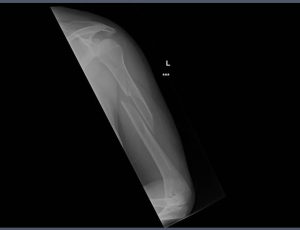 A humerus fracture is generally divided into three types of injuries: Proximal humerus, mid-shaft, and distal humerus fractures.
A humerus fracture is generally divided into three types of injuries: Proximal humerus, mid-shaft, and distal humerus fractures.
At the upper end, the surgical neck of the humerus and anatomical neck of humerus can both be involved.
Fractures of the surgical neck are more common, and the axillary nerve can be damaged in fractures of this type.
Proximal humeral fractures account for 5-6% of all adult fractures.
Estimated 706,000 proximal numeral fractures occurred worldwide in 2000.
Proximal humeral fractures are increasing 2.5 fold in women and 3.4 fold increase in men older than 60 years.
Approximately 50% proximal humeral fractures are displaced, the majority of which involve the surgical neck, (77%).
The head of humerus fracture is considered a proximal humerus fracture and may involve the insertion of rotator cuff tendons.
Incidence of proximal humerus fractures is on the rise as populations age.
No consensus exists regarding the optimal treatment of displaced proximal humeral fractures in elderly patients.
A study evaluating the clinical effectiveness of surgical vs nonsurgical treatment for adults with displaced fractures of the proximal humerus involving the surgical neck found no significant difference in the primary endpoint of Oxford Shoulder Score.
In 2008, humerus fractures accounted for approximately 370,000 emergency department visits in the US.
Proximal humerus fractures, the most common, account for 50% of the total.
The incidence of proximal humerus fractures increases exponentially for women between the ages of 40 and 84, and for men between the ages of 60 and 89.
The risk of proximal humerus fractures is frequently attributed to osteoporosis.
In The Proximal Fracture of the Humerus Evaluation by Randomization (PROFHER) trial:
231 patients sought care within 3 weeks after sustaining a displaced fracture of the proximal humerus involving the surgical neck and randomized to surgery versus nonsurgical management:there were no significant differences in the groups, suggesting non-surgical treatment should be the preferred management.
In a randomized clinical trial of 82 patients with humeral shaft fractures patients treated with closed displaced humeral shaft fractures, internal fixation surgery compared to non-operative functional bracing did not significantly improve functional outcomes at 12 months (RAMO L).
The incidence of proximal humerus fractures increases exponentially for women between the ages of 40 and 84, and for men between the ages of 60 and 89.
The risk of proximal humerus fractures is frequently attributed to osteoporosis.
The incidence of proximal humerus fractures increases exponentially for women between the ages of 40 and 84, and for men between the ages of 60 and 89.
The risk of proximal humerus fractures is frequently attributed to osteoporosis.
In The Proximal Fracture of the Humerus Evaluation by Randomization (PROFHER) trial:
231 patients sought care within 3 weeks after sustaining a displaced fracture of the proximal humerus involving the surgical neck and randomized to surgery versus nonsurgical management:there were no significant differences in the groups, suggesting non-surgical treatment should be the preferred management.
No consensus exists regarding the optimal treatment of displaced proximal humeral fractures in elderly patients.
A study evaluating the clinical effectiveness of surgical vs nonsurgical treatment for adults with displaced fractures of the proximal humerus involving the surgical neck found no significant difference in the primary endpoint of Oxford Shoulder Score.
In 2008, humerus fractures accounted for approximately 370,000 emergency department visits in the US.
Proximal humerus fractures, the most common, account for 50% of the total.
The incidence of proximal humerus fractures increases exponentially for women between the ages of 40 and 84, and for men between the ages of 60 and 89.
The risk of proximal humerus fractures is frequently attributed to osteoporosis.
In The Proximal Fracture of the Humerus Evaluation by Randomization (PROFHER) trial:
231 patients sought care within 3 weeks after sustaining a displaced fracture of the proximal humerus involving the surgical neck and randomized to surgery versus nonsurgical management:there were no significant differences in the groups, suggesting non-surgical treatment should be the preferred management.
Mid-shaft humerus fractures occur away from the shoulder and elbow joints and most humeral shaft fractures will heal without surgery,
Mid-shaft humerus fractures are commonly associated with injury to the radial nerve.
Distal humerus fractures are uncommon injuries in adults, occur near the elbow joint, and most often require surgical treatment.
Distal humerus fractures are much more common in children.
Humerus fractures are most commonly caused by falls.
Most humerus fractures heal without surgery.
The majority of patients can be treated with a sling or brace, and casting is not possible with most types of humerus fractures.
The most common concern related to non-operative treatment is nonunion with an incidence as high as 33%.
Surgery is required when the bone fragments are far out of alignment.
Surgery is however associated with infection and iatrogenic radial nerve palsy.
Fractures close to the shoulder and elbow joints, especially fractures that extend into the joint, are more likely to require surgery.
Fractures in the center of the shaft of the bone rarely require surgery, even with the bone fragments appear not perfectly aligned.
In a randomized clinical trial among patients with displaced proximal fractures involving the surgical neck, there was no significant difference between the surgical treatment compared with non-surgical treatment in patient’s clinical outcome over two years following fracture.: Results do not support the trend of increased surgery for patients with displaced fractures of the proximal humerus (Rangan A et al).
One of the commonly associated problems with humerus fractures is injury to the radial nerve, as it wraps around the humerus bone, and travels all the way down to the hand.
The damage to the radial nerve is almost always temporary, but may notice abnormal sensation over the back of the hand, and weakness of some of the muscles of the hand and wrist.
Over 90% of patients with humerus fractures and radial nerve damage will have complete recovery of the nerve within 3 to 4 months.
